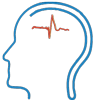- Guillain–Barré syndrome (GBS) is a complex disease characterised by quickly progressing, symmetrical limb weakness with hyporeflexia or areflexia; sensory abnormalities and cranial nerve impairments might develop in certain individuals.
- Additional tests (such as CSF fluid examination and nerve conduction studies) might help corroborate the clinical diagnosis of GBS, which is particularly important in individuals with unusual characteristics or diagnostic uncertainty.
- GBS etiology involves molecular mimicry, antiganglioside antibodies, and, most likely, complement activation; a possible role for genetic predisposition awaits additional exploration.
- Intravenous immunoglobulin and plasma exchange have been shown to be successful treatments.
- Pain is a significant symptom that may be present prior to the development of weakness and might impede proper diagnosis, particularly in youngsters; other residual signs (sensory abnormalities and exhaustion) may last for years.
- Even early in the course of the illness, prognostic models can predict patient outcomes at 4 weeks, 3 months, and 6 months, as well as the likelihood of respiratory insufficiency.
Diagnosis of Guillain barre syndrome by NCV
Nerve conduction studies (NCS) may aid in the clinical diagnosis of GBS by distinguishing between axonal and demyelinating subtypes. GBS diagnosis may be challenging in the early stages of the illness, particularly if reflexes are still intact if the weakness is not spread in the characteristic pattern (for instance, in patients with paraparesis). NCS may reveal anomalies in areas of preclinical illness, such as the arms. NCS observations of peripheral neuropathy or polyradiculopathy might also aid in the confirmation of GBS diagnosis.
Nerve conduction anomalies often peak more than two weeks following the beginning of weakness.
However, if NCS is necessary to confirm a suspected GBS diagnosis, a 2-week wait is often insufficient. Although NCS may be conducted early in the disease’s progression, the findings may be normal at this point. Prolonged or missing F-waves are often the first-detected NCS abnormalities, however additional conduction abnormalities emerge as the illness develops. At least four motor nerves, three sensory nerves, and F-waves should be explored to improve the diagnostic yield of NCS.
The abnormalities discovered on NCS are determined by the GBS subtype (AIDP, AMAN, or AMSAN). NCS reveals demyelination symptoms in AIDP patients, such as delayed distal motor latency, decreased nerve conduction velocity, prolonged F-wave latency, increased temporal dispersion, and conduction block. The sural sensory potential is often retained. Axonal GBS (AMAN or AMSAN) is distinguished by reduced motor and/or sensory amplitudes in the absence of demyelinating characteristics. Sensory-nervous investigations may assist in distinguishing between AMAN and AMSAN.
Neurophysiological results in AMAN may be quite complicated since some individuals exhibit transitory conduction block or slowness that quickly recovers throughout the course of the disease—a phenomenon known as reversible conduction failure.
Reversible conduction failure may resemble demyelination and is most likely caused by antiganglioside antibodies impairing conduction at the node of Ranvier. Aside from reversible conduction failure, additional NCS characteristics suggestive of demyelination may be seen in the acute phase of axonal GBS. Patients with reversible conduction failure may be misdiagnosed with AIDP rather than AMAN. Serial NCS may be required to accurately identify these two GBS subtypes.
Subtype categorization does not seem to alter treatment decisions, since individuals with axonal and demyelinating GBS get similar therapy after confirmation diagnosis by Nerve conduction study.
Book your appointment for EMG and NCV test at Dr. Poornima’s neurodiagnosis clinic or if you experience the above symptoms consult Dr. Poornima Shah one of the top neurophysiologists in Mumbai.

